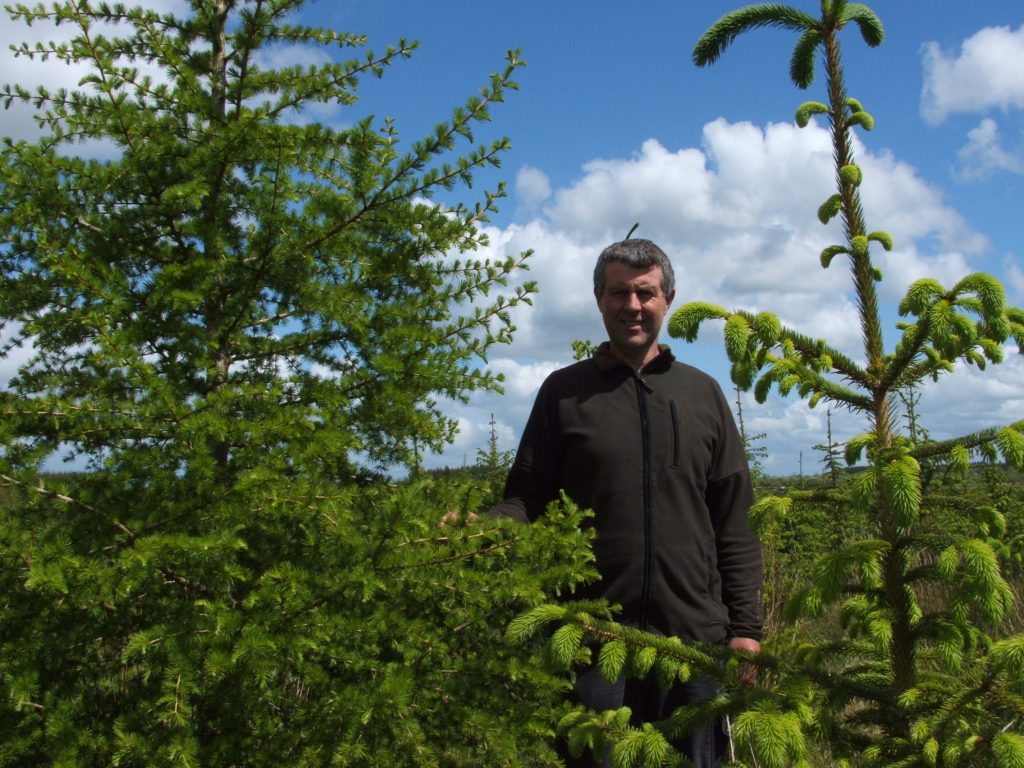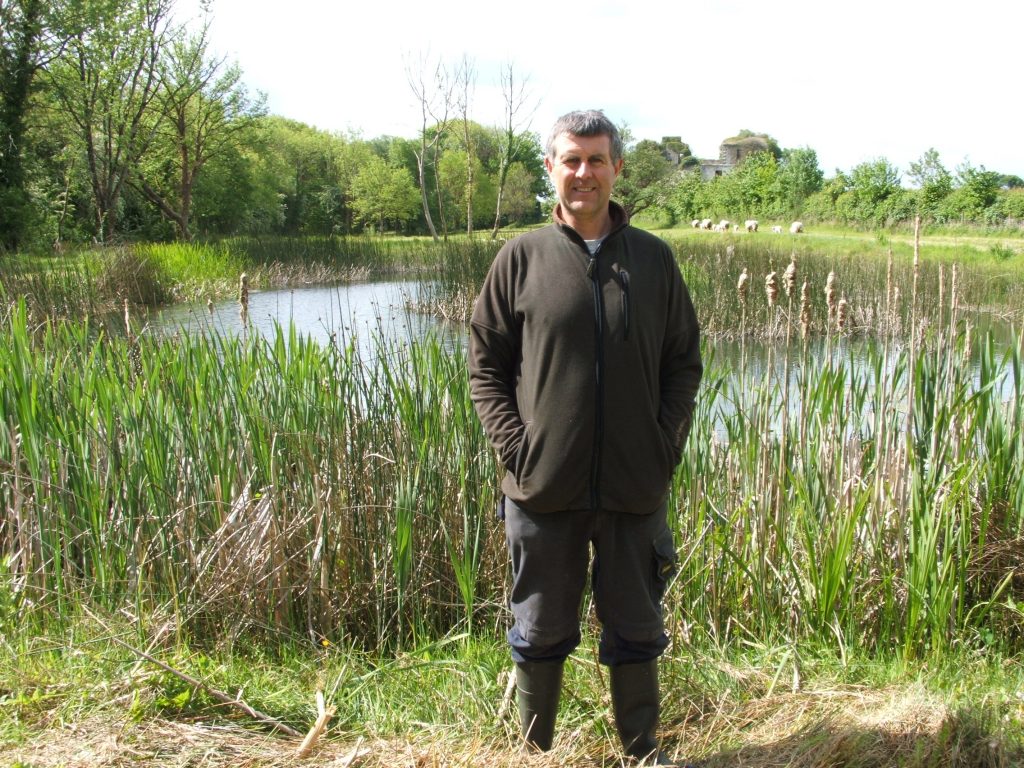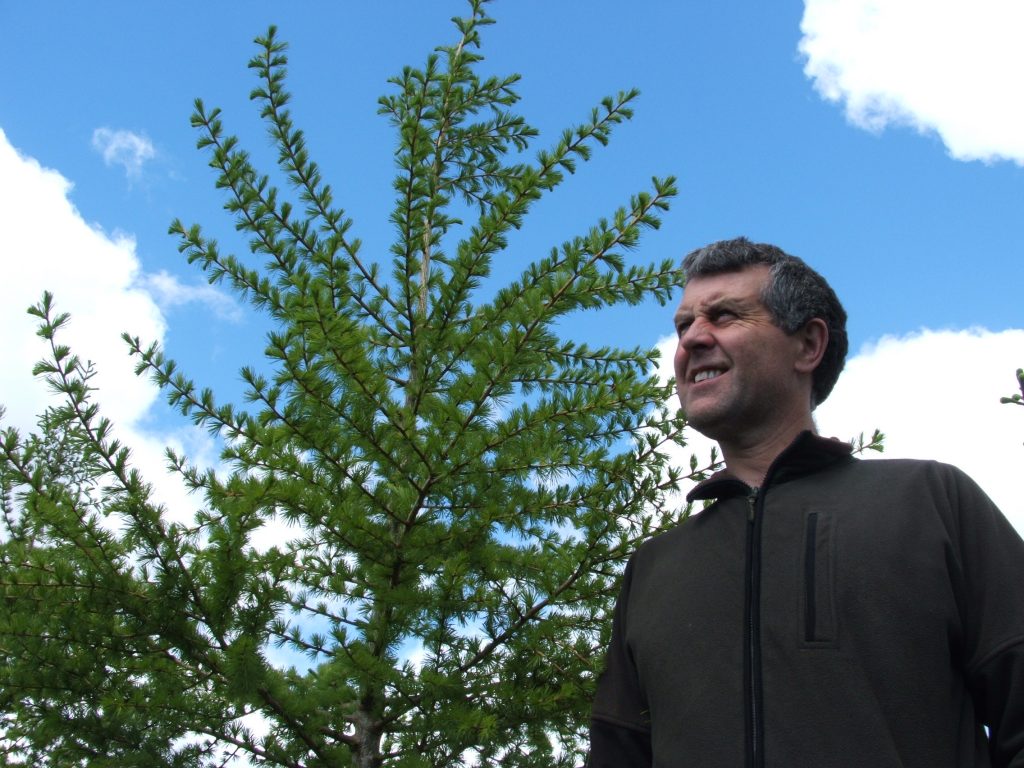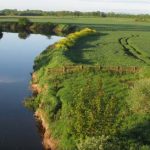In a previous article, Donal Daly introduced the concept of…
Forestry – satisfying hearts and minds
Farm woodlands are making a growing contribution to Padraig Corcoran’s quest for environmental, social and economic farm sustainability.
“This was my playground when I was a child” muses Roscommon farmer Padraig Corcoran as we approach his twelve acres of two-hundred-year-old broadleaf woodland which is the beating heart of Mount Plunkett Nature Reserve.
Adjoining the canal which links Lecarrow village, just north of Athlone, with nearby Lough Ree, the woodland and associated wetlands are the jewels in the crown of Padraig’s farm which he has been managing for the past twenty years, and where with an infectious enthusiasm he has established the nature reserve with the protection of nature and wildlife at the heart of everything he does.

PADRAIG IN MOUNT PLUNKETT NATURE RESERVE 
PADRAIG IN HIS PLANTATION WHICH INCLUDES JAPANESE LARCH, SITKA SPRUCE AND BROADLEAVES. 
WOODLAND AND WETLAND RESTORATION ENHANCING FARM BIODIVERSITY 
FARM WOODLANDS – SATISFYING HEARTS AND MINDS
Satisfying hearts – farming conservation
Outside the woodland Padraig’s farm would be considered small and extensive – he farms eighty-one acres – sixteen rented – with sheep and store cattle – a typical Roscommon farm. But his impeccable environmental and conservation credentials are reflected in his long-term involvement in agri-environment schemes, from REPs right up to GLAS – planting hedges and trees, putting up nesting boxes, developing species-rich wetland and creating plots of wild bird cover.
On a breezy sunny morning, the woodland is in full leaf – mature Ash, Oak, Beech, Sycamore and remarkably Elm look down on Hazel, Holly and Spindle. In brighter gaps a new generation of younger trees are growing. A handful of ewes and lambs meander through, lightly grazing on the nutritious herb layer in the shelter of the trees. There is a cacophony of birdsong.
Woodland restoration
It wasn’t always this idyllic. “Before I bought it in 2005 the woodland, right down to the canal, was completely abandoned for more than twenty-five years” says Padraig. ”It was a mess and when I got the chance I jumped at the opportunity to buy it and begin to restore it.” For Padraig this means restoring and managing both woodland and wetlands in the traditional style of farming – High Nature Value farming in today’s terminology. Because the area is in the Lough Ree Special Area of Conservation this involves consultation with the National Parks and Wildlife Service and other agencies to sensitively manage the multiple services provided by the woodland.
To support the sustainable development of the woodland Padraig recently got approval for funding under the Native Woodland Conservation scheme. Administered by the Department of Agriculture and the Marine’s Forest Service, the scheme prioritises sites of high ecological significance where native woodland restoration will ‘deliver’ benefits regarding the protection of watercourses and aquatic habitats.
Spreading the message
Padraig is passionate and proud of what he has achieved but he is anxious to spread the message to policymakers that more joined up thinking is required between farming and the environment to ensure that production is sustainable – economically, socially and environmentally.
Perhaps the real strength of Mount Plunkett is in the education it offers as a demonstration of
what can be done. Since 2006 Padraig has hosted numerous visits and courses involving agencies ranging from Teagasc to Birdwatch Ireland and the National Parks and Wildlife Service to the annual Roscommon Lamb Festival to name but a few. Padraig particularly welcomes local schoolchildren who he describes as “open and enthusiastic sponges for knowledge, information and ideas.”
Satisfying minds – production forestry
But for Padraig farming is also about being a pragmatist. His is not a big farm and by 2012 he began to appreciate the reality of modern farming – longer hours and reducing returns even with an off-farm job. With the future of his young family to consider, he saw that in order to continue to sustainably manage the land an alternative secure source of income would be necessary.
As Padraig saw it the environmental focus on farming was only going to get stronger with a particular emphasis on the protection of water quality and reducing the carbon footprint. He set about seeking an alternative farm enterprise with an environmental profile to complement his own farming system.
Forestry ticked all the right boxes as an enterprise offering these environmental benefits and more, coupled with guaranteed annual premiums and retention of the Basic Payment.
Having sourced land – marginal for farming but highly productive for forestry – Padraig planted his first farm forest – 8.8 hectares of Sitka spruce, Japanese larch and broadleaves in 2012.
Every year since then he has been planting an additional 6-8 hectares and is planning a further 4 hectares in the back end of the year. He has engaged a local Roscommon forestry company to do most of his planting but in 2015 he planted 3 hectares himself and, not surprisingly, is following its progress with particular interest. “To get the best from forestry owners need to be in touch with what’s going on” says Padraig. “Planting a few trees or doing a bit of grass cleaning is great experience and is good for them and the trees.”
In the same spirit of openness evident in Mount Plunkett earlier this year Padraig hosted a Teagasc walk where forest owners learnt about the management of young plantations.
Padraig is delighted with the growth so far in his young plantations and their unashamedly strong focus on the production of commercial softwood. “Today’s plantations match strong environmental measures with really fast tree growth” he comments “The trees are carbon neutral and a renewable resource – I see them as complementing the woodland conservation work in Mount Plunkett and helping to sustain the way, we as a family, want to see the farm develop.”
Noel Kennedy, Teagasc Forestry Development Department
This article originally appeared in Today’s Farm







